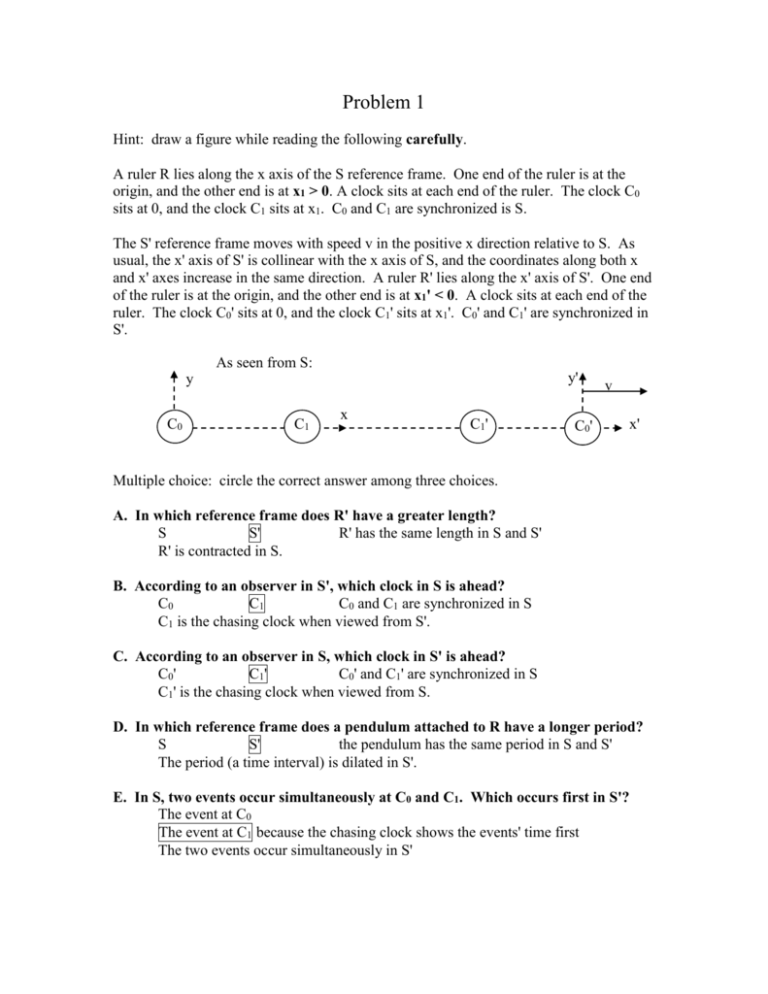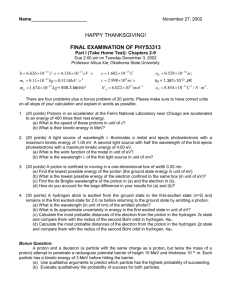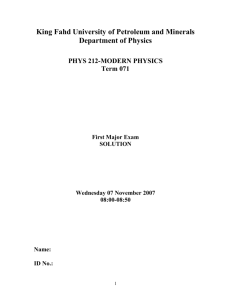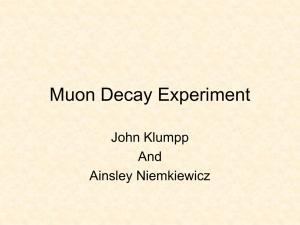Problem 1
advertisement

Problem 1
Hint: draw a figure while reading the following carefully.
A ruler R lies along the x axis of the S reference frame. One end of the ruler is at the
origin, and the other end is at x1 > 0. A clock sits at each end of the ruler. The clock C0
sits at 0, and the clock C1 sits at x1. C0 and C1 are synchronized is S.
The S' reference frame moves with speed v in the positive x direction relative to S. As
usual, the x' axis of S' is collinear with the x axis of S, and the coordinates along both x
and x' axes increase in the same direction. A ruler R' lies along the x' axis of S'. One end
of the ruler is at the origin, and the other end is at x1' < 0. A clock sits at each end of the
ruler. The clock C0' sits at 0, and the clock C1' sits at x1'. C0' and C1' are synchronized in
S'.
As seen from S:
y'
y
C0
C1
x
C1 '
C0 '
v
x'
Multiple choice: circle the correct answer among three choices.
A. In which reference frame does R' have a greater length?
S
S'
R' has the same length in S and S'
R' is contracted in S.
B. According to an observer in S', which clock in S is ahead?
C0
C1
C0 and C1 are synchronized in S
C1 is the chasing clock when viewed from S'.
C. According to an observer in S, which clock in S' is ahead?
C0 '
C1 '
C0' and C1' are synchronized in S
C1' is the chasing clock when viewed from S.
D. In which reference frame does a pendulum attached to R have a longer period?
S
S'
the pendulum has the same period in S and S'
The period (a time interval) is dilated in S'.
E. In S, two events occur simultaneously at C0 and C1. Which occurs first in S'?
The event at C0
The event at C1 because the chasing clock shows the events' time first
The two events occur simultaneously in S'
Problem 2
Muons are unstable particles formed high in the atmosphere. When observed at rest, their
lifetime is 2.2 s. Suppose that a group of a million muons is formed at an altitude of
1000 m (in the Earth's reference frame). Suppose further that this group of muons travels
straight downward with speed 0.8c.
A. In the muons' reference frame, how far do the muons begin from the Earth's surface?
1000 m is the proper distance in the Earth's frame, so the contracted distance is 1000 m/
= 1000 m (1 – v2/c2)1/2 = 1000 m (1 – 0.82)1/2 = 600 m
B. In the Earth's reference frame, how long after the muons' formation do the muons
arrive at the Earth's surface?
time = distance/speed = 1000 m/0.8c = 4.17 s
C. How many muons arrive at the Earth's surface?
In the muons' frame, the muons begin 600 m from the Earth, so it takes 600 m/0.8c = 2.5
s for the Earth's surface to reach the muons. The muons decay with their proper lifetime
during this time interval: N = N0e-t'/ = 106e-2.5/2.2 = 321,000
Alternative solution: In the Earth's frame, the muons travel for 4.17 s while decaying
with a dilated lifetime of 2.2 s = 3.67 s. N = N0e-t'/ = 106e-4.17/3.67 = 321,000
Suppose a high-flying scientific instrument happens to be present in the atmosphere at
precisely the location where the muons are formed. At the moment the muons are
formed, the instrument emits a pulse of light straight down to Earth. Define two events
as follows:
Event 1: The pulse of light arrives at the Earth's surface.
Event 2: The muons arrive at the Earth's surface.
D. In the Earth's reference frame, what is the time interval between the two events?
The light arrives after time 1000 m/c. The muons arrive after time 1000 m/0.8c. So the
time interval between these two events is (1000 m/0.8c – 1000 m/c) = 8.33 10-7 s
E. In the muons' reference frame, what is the time interval between the two events?
The time interval between the two events is a proper time interval in the Earth's frame, so
we can multiply by to find the time interval in the muons' frame: 1.39 s
Alternative solution: The light and the Earth collide after time 600 m/(c + 0.8c). The
Earth reaches the muons after time 600 m/0.8c. So the time interval between these two
events is [600 m/0.8c - 600 m/(c + 0.8c)] = 1.39 s
Problem 3
A train approaches a tunnel with speed v = 0.6c. In the train's reference frame, the train
has length 1000 m. Also in the train's reference frame, the tunnel has length 1000 m.
Define two events as follows:
Event 1: The back of the train enters the tunnel.
Event 2: The front of the train exits the tunnel.
A. What is the proper length of the tunnel?
1000 m = 1250 m
B. Is there a reference frame in which Events 1 and 2 are simultaneous? If so, describe
it. If not, why not?
The two events are simultaneous in the train's reference frame because the train and the
tunnel have the same length in the train's frame.
C. In the tunnel's reference frame, what is the time interval between the two events?
Which event occurs first (if they are not simultaneous)?
In the tunnel's frame, the train has length 1000 m/ = 800 m.
1250 m
tunnel
train
800 m
The train must travel 450 m between Events 1 and 2, so Event 1 occurs 450 m/0.6 c = 2.5
s before Event 2.
D. In the train's reference frame, what is the time interval between the two events?
Which event occurs first (if they are not simultaneous)?
The two events are simultaneous in the train's frame because the train and the tunnel have
the same length in this frame.
E. Is there a reference frame in which the train's length is equal to the proper length of
the tunnel? If so, describe it. If not, why not?
The proper length of the tunnel is greater than the proper length of the train. There is no
frame in which the train has a length greater than its proper length.
Problem 4
When a beam of high-energy protons collides with protons at rest in the laboratory frame,
neutral pions (0) are produced by the reaction p + p p + p + 0. The kinetic energy of
each incoming high-energy proton is Ek'. We want to know the smallest Ek' required for
the reaction to take place.
A. Consider the reactants (one high-energy proton and one proton at rest in the
laboratory frame). In the zero-momentum frame, each proton is approaching the other
with speed u. What is the sum of the kinetic energies of the two protons in the zeromomentum frame? Find an algebraic expression: leave your answer as a function of u, c,
and m, the mass of a proton.
2[mc2/(1 – u2/c2)1/2 – mc2]
B. Suppose that in the zero-momentum frame, all of the initial kinetic energy is
converted into the rest energy of the pion. (This occurs when the kinetic energy is the
smallest amount required for the reaction to take place.) Find a numerical value for u/c
(where u is the initial speed of each proton in the zero-momentum frame), given that the
rest energy of a proton is 938 MeV, and the rest energy of a pion is 135 MeV.
Set the above expression, where mc2 = 938 MeV, equal to 135 MeV:
2[938 MeV/(1 – u2/c2)1/2 – 938 MeV] =135 MeV
1/(1 – u2/c2)1/2 – 1 = 135/(2938)
(1 – u2/c2)1/2 = 1/[135/(2938) + 1]
u2/c2 = 1 - 1/[135/(2938) + 1]2
u/c = {1 - 1/[135/(2938) + 1]21/2 = 0.360
C. Find the numerical value of u'/c, where u' is the initial speed in the laboratory frame
of a high-energy proton with the smallest energy required for the desired reaction.
y
u
y'
x
-u
Lab
x'
The Galilean transformation would give u' = 2u, but the relativistic transformation
requires a denominator: u' = 2u/(1 + u2/c2) = 2 0.36c/(1 + 0.362) = 0.637c, or u'/c =
0.637
D. Find the numerical value of Ek', the initial kinetic energy in the laboratory frame of a
high-energy proton with the smallest energy required for the desired reaction. (Don't
forget units!)
Ek' = mc2/(1 – u'2/c2)1/2 – mc2 = 938 MeV/(1 – 0.6372)1/2 – 938 MeV = 280 MeV
E. Explain why the following argument is incorrect:
"The rest energy of a pion is 135 MeV, so if one proton is at rest in the laboratory frame,
a second proton with a kinetic energy of 135 MeV has the minimum kinetic energy
required for the reaction p + p p + p + 0."
Momentum must be conserved as well as energy. If all of the high-energy proton's
kinetic energy becomes the rest energy of the pion, nothing is left over for kinetic energy.
So there would be no final kinetic energy and therefore no final momentum. But the
high-energy proton has initial momentum that needs to be conserved.








